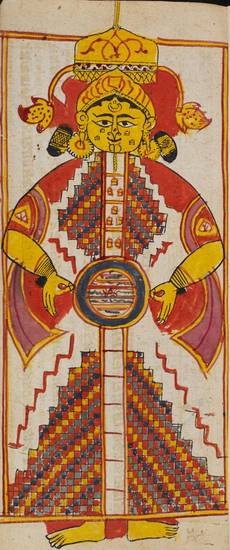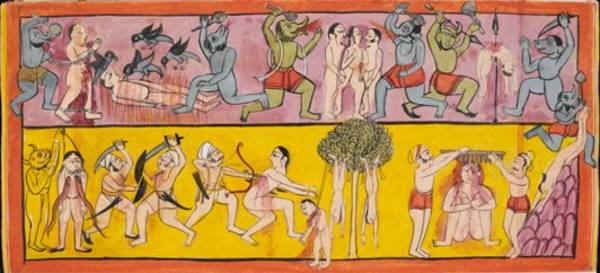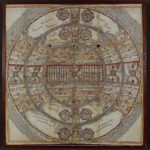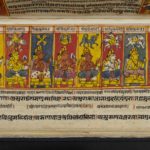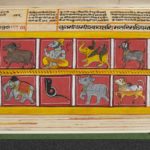Article: The ‘Three Worlds’
The Jain conception of the universe is very complex, composed of symmetrical, repeating patterns based on mathematical principles. Central religious concepts such as the soul, karma, the cycle of birth and spiritual progression are tied into the structure of the universe and the cycle of time, so understanding cosmology is a key element of the Jain tradition.
The Jain universe is made up of two kinds of space. World space – loka-ākāśa – is limited, though enormous, and is where the three worlds of life are. Outside it stretches the infinite expanse of non-world space – aloka-ākāśa.
The universe is filled with three worlds, which are divided into lower, middle and upper.
‘Sermon on the Universe’ in the Triṣaṣṭiśalākāpuruṣacarita
Hemacandra
translated by Johnson, page 104
The three worlds within world space are where all the souls are. They move through the lower, middle and upper worlds on their spiritual journey and at the end dwell above the worlds in eternal bliss in the siddha-śilā. This transmigration is called the cycle of birth. Where the souls are born and their condition in that birth depends on their karma, which comes from behaviour in earlier lives. Jains hope to advance spiritually to omniscience and then liberation from the cycle of birth so their souls can reach the siddha-śilā.
Understanding and meditating upon Jain cosmological theories are necessary parts of spiritual development. As essential elements of the religion, these complex notions have been passed down since the earliest times in oral, literary and visual art forms. The best-known diagram of world space is the cosmic man. This phrase is often used instead of the term ‘the three worlds’.
Cycle of birth and types of beings
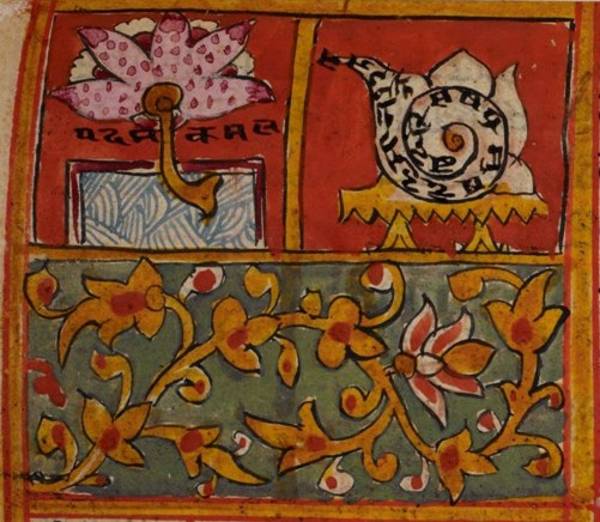
Plants and two-sensed beings
Image by British Library © CC0 1.0 (Creative Commons Public Domain)
The intertwined relationship of karma and cosmology in Jainism is clear in the notion of the three worlds and how souls move among these worlds over their cycles of births.
Souls are born into a succession of various bodies in different parts of the worlds. There are four states – gati – into which they can be born. The world into which they are born and the body they have in that birth or lifetime depend on their spiritual condition. This is largely determined by the karma that has become attached to the soul over the course of the previous life and also, to some extent, the karma from previous lives. A soul may therefore be born in a hell in one rebirth and in a heaven in the next – it may not move among the different worlds in a straightforward way, going either all up in succession or all down in succession.
The more advanced a soul’s spirituality, the higher the world into which it is born. However, being born a human being in the middle world is better than being born into one of the heavens of the upper world. This is because only human beings can reach omniscience, which is a late, necessary stage on the way to liberation, and human beings can live only in the middle world.
Living beings can be classified in various ways, based on their state and on the number of senses they have. Certain types of beings are also categorised into different groups.
Four types of beings
The soul can be reborn in four types of conditions in each of the three worlds. The state of birth depends on the karma that has become attached to the soul in previous lives.
The soul can be born in one of the following ways – gati – namely as:
- a human being – manuṣya-gati
- a heavenly being, living in the heavens – deva-gati
- an infernal being, living in the hells – naraka-gati
- an animal or plant – tiryag-gati.
Sense-beings
All beings are also classified into groups according to their number of sense-organs, from one to five. The following hierarchy is a summary of extremely detailed sub-classifications and lists, based on Lecture 36, ‘On Living Beings and Things Without Life’ in the Uttarādhyayana-sūtra.
This table is based on Śvetāmbara sources. Details of the Digambara tradition can be found in Jainendra Siddhānta-kośa. A comprehensive scholarly survey of both sects‘ sources is Kirfel 1920.
|
Number of senses |
Sense |
Examples |
|---|---|---|
|
1 |
|
|
|
2 |
|
|
|
3 |
|
|
|
4 |
|
|
|
5 |
|
|
Classes of gods
It is important to note that not all heavenly beings, who can also be called gods or deities, live in the upper world. It would be wrong to automatically connect the concept of ‘god’ with that of heaven.
The connection between the four classes of gods and their dwelling place is provided in the table.
|
Type of god |
Dwelling place |
|---|---|
|
Bhavanavāsin or Bhavanapati |
under the earth, in palaces in the first hell |
|
Vyantara |
under the earth, in palaces and cities in the space between the first hell and the surface of the earth |
|
Jyotiṣka or astral bodies, such as the sun and moon |
middle world, between earth and sky |
|
upper world, in the various heavens |
Cosmic man
The different elements of the world space in the Jain universe are very frequently drawn as parts of a stylised figure of a man. Called the cosmic man, this diagram is probably the most widely known representation of the Jain universe. The name is often used in place of the term ‘the three worlds’.
A statement found in the fifth Aṅga of the Śvetāmbara canonical scriptures describes the shape of the world – loka – as broad at the bottom, narrowing towards the middle and gradually broadening again towards the top. The world is measured in length, breadth and height, in the unit known as ‘rope’ or rajju. The total height is 14 rajjus.
A good diagram of the cosmic dimensions and the representation of the three worlds is figure 7 in That Which Is.
In the early medieval period, the standard representation of the three worlds is the cosmic man – loka-puruṣa. He comprises the:
- lower pyramid, representing the lower world – adho-loka – which is divided into seven levels, corresponding to as many hells
- middle world – madhya-loka – at his waist
- upside-down pyramid that is his torso, symbolising the upper world – ūrdhva-loka – which is divided into various levels that indicate the heavens.
Finally, liberated souls – siddha – live at the top of all the worlds in the siddha-śilā, signified by the white crescent moon on the cosmic man’s forehead.
The worlds are usually portrayed from a frontal view of the cosmic man, which emphasises that the middle world is the smallest of the three worlds. However, it is the most important from the spiritual point of view because it is the only part of the worlds where human beings can live.
Three worlds and the worlds in between
Each one of the three worlds is made up of several elements, all featuring noticeable repetition and symmetry.
Lower world – the seven hells
The lower world is the world of suffering. The lower one lives, the more one suffers. Depictions of life there and the varieties of tortures one can suffer there are among artists’ favourite topics, producing very lively paintings.
There are seven hells in the lower world, with several formed of layers of hells. The following table presents information about the hells. This table is based on Śvetāmbara sources. Details of the Digambara tradition can be found in Jainendra Siddhānta-kośa. A comprehensive scholarly survey of both sects‘ sources is Kirfel 1920.
|
Number |
Name |
Meaning |
Depth – yojanas |
Number of layers |
|---|---|---|---|---|
|
1 |
Ratna-prabhā |
jewels |
180,000 |
|
|
2 |
Śarkara-prabhā |
gravel |
132,000 |
|
|
3 |
Vālukā-prabhā |
sand |
128,000 |
9 |
|
4 |
Paṅka-prabhā |
mud |
120,000 |
7 |
|
5 |
Dhūma-prabhā |
smoke |
118,000 |
5 |
|
6 |
Tama[ḥ]-prabhā |
darkness |
116,000 |
3 |
|
7 |
Tamatama[ḥ]-prabhā |
extreme darkness |
108,000 |
1 |
The lower a hell is, the wider its base is. But the thickness of the hells decreases the lower it is. For example the seventh hell has one layer whereas the third hell has nine layers. These characteristics can be seen in the cosmic man.
The first hell from the top is where the ten groups of beings live that comprise the category Bhavana-pati or Bhavana-vāsin – ‘Residents of Dwellings’. They are princes – kumāras – and form the lowest group of deities that can be found in the triple world.
|
Number |
Names of princes |
Meaning |
Emblem |
Names of kings – indras |
|---|---|---|---|---|
|
1 |
Asura-kumāra |
fiendish youths |
head-jewel |
Camara and Bali |
|
2 |
Nāga-kumāra |
serpentine youths |
snakehood |
Dharaṇa and Bhūtānanda |
|
3 |
Vidyut-kumāra |
lightning youths |
thunderbolt |
Hari and Harisaha |
|
4 |
Suparṇa-kumāra |
vulpine youths |
Veṇudeva and Veṇudārin |
|
|
5 |
Agni-kumāra |
fiery youths |
jar of plenty |
Agniśikha and Agnimāṇava |
|
6 |
Vāyu-kumāra |
stormy youths |
horse |
Velamba and Prabhañjana |
|
7 |
Stanita-kumāra |
thundering youths |
symbol of prosperity – vardhamāna |
Sughoṣa and Mahāghoṣa |
|
8 |
Udadhi-kumāra |
oceanic youths |
dolphin – makara |
Jalakānta and Jalaprabha |
|
9 |
Dvīpa-kumāra |
island youths |
lion |
Pūrṇa and Avaśiṣṭa |
|
10 |
Dik-kumāra |
youths ruling the cardinal points |
elephant |
Amita and Amitavāhana |
The three highest hells are where the semi-divine beings live, who are known as the Paramādharmika – ‘Extremely Unjust’.
All these beings live in palaces – vimānas – that are round, triangular or square. They are grouped around a circular palace where their respective kings live.
Rebirth in the lower world
Rebirth in the hells results from violent behaviour and extreme possessiveness.
The types of infernal beings are born in different hells, as shown in the following table, which is based on page 76 of Jaini in Granoff 2009. The hells are numbered according to how deep they are, with number one at the highest level.
|
Level of hell |
Type of animal born there |
|---|---|
|
1 |
only five-sensed animals without the faculty of mind |
|
2 |
reptiles with legs |
|
3 |
birds |
|
4 |
land animals, such as lions |
|
5 |
legless reptiles |
|
6 |
female humans |
|
7 |
male humans and aquatic animals, such as fish, sharks and crocodiles |
If they do not gain enough good karma to be reborn in a higher world, they are born in a lower hell in their next birth.
Apart from those born in the top hell, infernal beings are reborn with five senses and the faculty of mind. They have a sort of negative capacity of knowledge – vibhaṅga – through which they can remember their earlier enemies and carry on holding feelings of hostility. They can change their appearance and form to frighten other beings.
Between the first hell and the middle world
Above the first hell live the semi-divine beings called Vyantaras. There are eight categories of Vyantara. They are the second class of gods and are recognisable by their different emblems. Each of the eight groups is governed by two kings – indras – with full courts and retinues.
The following table gives key details of the Vyantara deities. The table is based on Śvetāmbara sources. Details of the Digambara tradition can be found in Jainendra Siddhānta-kośa. A comprehensive scholarly survey of both sects‘ sources is Kirfel 1920.
|
Type |
Name |
Meaning |
Emblem |
Names of the two kings |
|---|---|---|---|---|
|
1 |
Piśāca |
goblins |
kadamba tree |
Kāla and Mahākāla |
|
2 |
Bhūta |
devils |
sulasa tree |
Surūpa and Apratirūpa |
|
3 |
treasure keeper |
banyan tree |
Pūrṇabhadra and Maṇibhadra |
|
|
4 |
Rākṣasa |
demons |
khaṭvānga tree |
Bhīma and Mahābhīma |
|
5 |
Kinnara |
deformed humans |
aśoka tree |
Kinnara and Kimpuruṣa |
|
6 |
Kiṃpuruṣa |
deformed persons |
campaka tree |
Satpuruṣa and Mahāpuruṣa |
|
7 |
Mahoraga |
great serpents |
nāgadru tree |
Atikāya and Mahākāya |
|
8 |
Gandharva |
celestial musicians |
tumburu tree |
Gītarati and Gītayaśas |
Middle world – the world of humans
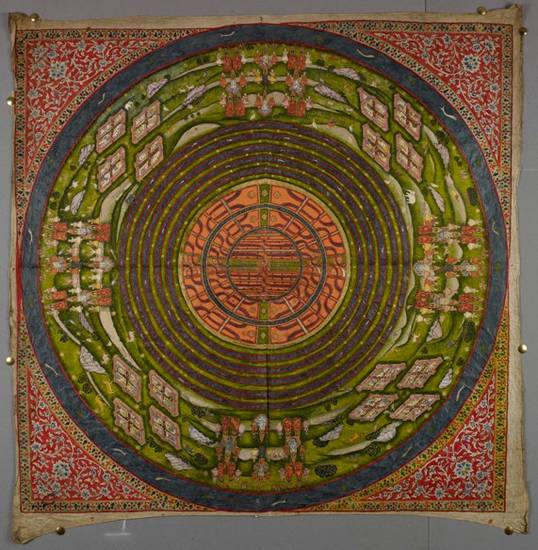
Two and A Half Continents
Image by British Library © CC0 1.0 (Creative Commons Public Domain)
The mathematics of the universe is complicated and highly detailed, making descriptions and images of the universe very intricate, but mathematical principles are closely observed. Repetition is a major trait of the Jain universe, which is very clear in the middle world in particular. The middle world is circular and is constituted of concentric rings of continents separated by rings of oceans. Each continent is a duplicate of the central one, Jambū-dvīpa, which itself is a complex of mathematical proportions. Each landmass and ocean increases by a factor of two going outwards from the middle, although this is not always obvious from illustrations.
There are 90 continents and oceans in the middle world but many are merely names, with very few details in cosmological texts. There are some significant continents, however. Jambū-dvīpa, the first or central continent, is the most important and is at the heart of the area known as the ‘Two and A Half Continents‘. The 15th continent, Nandīśvara-dvīpa, is important since it is where the gods gather to celebrate. It is often described elaborately. Finally, Kuṇḍala-dvīpa, the 12th continent from the centre, is often called ‘Ring’ or Kuṇḍala after its geography.
This chart gives the names of the continents and oceans of the middle world, starting from the centre. It is based on Śvetāmbara sources. Details of the Digambara tradition can be found in Jainendra Siddhānta-kośa. A comprehensive scholarly survey of both sects‘ sources is Kirfel 1920.
|
Continent |
Ocean |
|---|---|
|
1. Jambū-dvīpa |
|
|
4. Kālodadhi |
|
|
6. Puṣkaroda |
|
|
7. Vāruṇīvara |
8. Vāruṇoda |
|
9. Kṣīravara |
10. Kṣīroda |
|
11. Ghṛtavara |
12. Ghṛtoda |
|
13. Kṣodavara |
14. Kṣododa |
|
15. Nandīśvara-dvīpa |
16. Nandīśvaroda |
|
17. Aruṇa-dvīpa |
18. Aruṇa ocean |
|
19. Aruṇavara |
20. Aruṇavarāvabhāsa ocean |
|
21. Kuṇḍala-dvīpa |
22. Kuṇḍala ocean |
|
23. Kuṇḍalavara-dvīpa |
24. Kuṇḍalavara ocean |
|
25. Kuṇḍalavarāvabhāsa-dvīpa |
26. Kuṇḍalavarāvabhāsa ocean |
|
27. Śaṅkha |
28. Śaṅkha ocean |
|
29. Śaṅkhavara |
30. Śaṅkhavara ocean |
|
31. Śaṅkhavarāvabhāsa |
32. Śaṅkhavarāvabhāsa |
|
33. Rucaka |
34. Rucaka ocean |
|
35. Rucakavara |
36. Rucakavara ocean |
|
37. Rucakavarāvabhāsa |
38. Rucakavarāvabhāsa ocean |
|
39. Hāra |
40. Hāra ocean |
|
41. Hāravara |
42. Hāravara ocean |
|
43. Hāravarāvabhāsa |
44. Hāravarāvabhāsa ocean |
|
45. Ardhahāra |
46. Ardhahāra ocean |
|
47. Ardhahāravara |
48. Ardhahāravara ocean |
|
49. Ardhahārāvabhāsa |
50. Ardhahārāvabhāsa ocean |
|
51. Kanakāvali |
52. Kanakāvali ocean |
|
53. Kanakāvalivara |
54. Kanakāvalivara ocean |
|
55. Kanakāvalivarāvabhāsa |
56. Kanakāvalivarāvabhāsa ocean |
|
57. Ratnāvali |
58. Ratnāvali ocean |
|
59. Ratnāvalivara |
60. Ratnāvalivara ocean |
|
61. Ratnāvalivarāvabhāsa |
62. Ratnāvalivarāvabhāsa ocean |
|
63. Muktāvali |
64. Muktāvali ocean |
|
65. Muktāvalivara |
66. Muktāvalivara ocean |
|
67. Muktāvalivarāvabhāsa |
68. Muktāvalivarāvabhāsa ocean |
|
69. Ājina |
70. Ājina ocean |
|
71. Ājinavara |
72. Ājinavara ocean |
|
73. Ājinavarāvabhāsa |
74. Ājinavarāvabhāsa ocean |
|
75. Sūrya |
76. Sūrya ocean |
|
77. Sūryavara |
78. Sūryavara ocean |
|
79. Sūryavarāvabhāsa |
80. Sūryavarāvabhāsa ocean |
|
81. Deva |
82. Deva ocean |
|
83. Nāga |
84. Nāga ocean |
|
85. Yakṣa |
86. Yakṣa ocean |
|
87. Bhūta |
88. Bhūta ocean |
|
89. Svayambhūramaṇa |
90. Svayambhūramaṇa ocean |
Two and A Half Continents
The first continent, Jambū-dvīpa, is the model for the other continents, which are its duplicates. Its name means ‘Rose-apple continent’, from a rose-apple tree in the Uttara-kuru region, at the north of Mount Meru. This ‘tree’ is in fact a rock formation that looks like a tree (Jaini in Granoff 2009: 83). At its centre is Mount Meru, the cosmic axis.
Jambū-dvīpa is the centrepiece of Aḍhāī-dvīpa, which means ‘Two and A Half Continents’ in Hindi. It is the only part of the universe where human beings live.
The Two and A Half Continents is comprised of:
- Jambū-dvīpa
- Lavaṇa-samudra, the ocean around it
- the second continent, Dhātakīkhaṇḍa
- the ocean around that, called Kālodadhi
- the inner half of the Puṣkara continent.
Jambū-dvīpa – the first continent

Temple and terraces of Mount Meru
Image by British Library © CC0 1.0 (Creative Commons Public Domain)
The first continent, Jambū-dvīpa, plainly demonstrates the mathematical nature of the Jain universe. The original template for the other continents, which replicate it, the ‘Rose-apple Continent’ is formed of repetitive, often symmetrical, mathematical ratios of mountains, regions, lakes, rivers and so on.
Jambū-dvīpa is set within a rampart of diamonds, which is surrounded by a fence of jewels crowned by a high garland of lotuses made of gems.
In the centre of Jambū-dvīpa, normally yellow in pictures, is Mount Meru, the cosmic axis. It has three terraces, each smaller than the one below, all planted with parks and forests. A temple dedicated to the Jinas is at the top. Models of Mount Meru are often found in Jain temples and are objects of worship.
Reading
- Commentary on Tattvārtha Sūtra of Vācaka Umāsvāti
Pandit Sukhlalji - translated by K. K. Dixit
L. D. series; volume 44
L. D. Institute of Indology; Ahmedabad, Gujarat, India; 1974
- Steps to Liberation: 2500 Years of Jain Art and Religion
Jan van Alphen - Etnografisch Museum Antwerpen; Antwerp, Belgium; 2000
- ‘Une peinture cosmologique jaina déposée au Musée Guimet: texte et traduction’
Nalini Balbir - Bulletin d’Études Indiennes
volume 24–25
Association Française pour les Études Indiennes; Paris, France; 2006 to 2007
- ‘Le monde médian: une peinture cosmologique jaina sur tissu déposée au Musée Guimet’
Nalini Balbir - Arts Asiatiques
volume 64
École Française d’Extrême-Orient; Paris, France; 2009
- Elements of Jaina Geography: The Jambūdvīpasaṃgrahaṇī of Haribhadra Sūri
Haribhadra - translated and edited by Frank van den Bossche
Motilal Banarsidass; New Delhi, India; 2007
- Jain Cosmology
Colette Caillat and Ravi Kumar - translated by R. Norman
Bookwise (India) Pct. Ltd; New Delhi, India; 2004
- Essays on Jaina Art
Anand K. Coomaraswamy - edited by Richard J. Cohen
Indira Gandhi National Centre for the Arts and Manohar; New Delhi, India; 2003
- Victorious Ones: Jain Images of Perfection
Phyllis Granoff - Mapin Publishing Pvt. Ltd and Rubin Museum of Art, New York; Ahmedabad, Gujarat, India and New York, USA; 2009
- ‘Oceans, Islands and Sacred Mountains: Representations of Cosmic Geography in Jaina Art and Architecture’
Julia A. B. Hegewald - Cosmos: the Journal of the Traditional Cosmological Society
volume 16
Traditional Cosmological Society; 2000
- ‘Meru, Samavasaraṇa and Siṃhāsana: The Recurrence of Three-Tiered Structures in Jaina Cosmology, Mythology and Ritual’
Julia A. B. Hegewald - Kalhar (White Water-Lily): Studies in Art, Iconography and Archaeology of India and Bangladesh – Professor Enamul Haque Felicitation Volume
edited by Gerd R. Mevissen, Gourishwar Bhattacharya, Mallar Mitra and Sutapa Sinha
Kaveri Books; New Delhi, India; 2007
- Cosmology Old & New: Being a modern commentary on the fifth chapter of Tattvārthādhigama Sūtra
G. R. Jain - Jñānapīṭha Mūrtidevī granthamālā: English series; volume 5
Bhāratīya Jñānapīṭh Publication; New Delhi, India; 1991
- ‘Lokākāśa and Lokadhātu: A Comparison of Jain and Buddhist Cosmology’
Padmanabh S. Jaini - The Clever Adulteress and Other Stories: A Treasury of Jain Literature
edited by Phyllis Granoff
Mosaic Press; Oakville, Ontario, Canada; New York, USA; London, UK; 1990
- Die Kosmographie der Inder: nach den Quellen dargestellt
Willibald Kirfel - Georg Olms; Hildesheim, Lower Saxony, Germany; 1967
- The Scientific Foundations of Jainism
K. V. Mardia - edited by Dayanand Bhargava
Lala Sunder Lal Jain Research series; volume 5
Motilal Banarsidass; New Delhi, India; 1996
- Die Erlösungslehre der Jaina: Legenden, Parabeln, Erzählungen
- translated and edited by Adelheid Mette
Insel Verlag; Berlin, Germany; 2010
- The Doctrine of the Jainas: Described after the Old Sources
Walther Schubring - translated by Wolfgang Bühlen
edited by Satya Ranjan Banerjee
Lala Sunder Lal Jain Research series; volume 15
Motilal Banarsidass; New Delhi, India; 2000
- That Which Is: Tattvārtha Sūtra
Umāsvāti / Umāsvāmi - translated by Nathmal Tatia
Sacred Literature series
International Sacred Literature Trust in association with Harper Collins; London, UK; 1994
- Treasures of Jaina Bhandāras
Umakant Premanand Shah - L. D. series; volume 69
L. D. Institute of Indology; Ahmedabad, Gujarat, India; 1978
- Tiloyapannatti: Teaching on the Three Worlds
Yativṛṣabha - translated by Pandit Balchandra Shastri
edited by A. N. Upadhye and Hiralal Jain
Jaina Saṃskṛti Saṃrakshaka Sangha series
Jīvarāja Jaina Granthamālā; Solapur, Maharashtra, India; 2008
Links
- Jain universe
-
The Herenow4U website provides a detailed diagram of the Jain universe and a summary of traditional cosmology. It is a page from the 2008 edition of Introduction to Jainism by Rudi Jansma and Sneh Rani Jain.
- Restoring a Jain paṭa
-
The National Museum of Scotland provides details of restoration carried out on a 19th-century wall-hanging – paṭa – of the Jain triple world. A slideshow of photographs of the conservation process and some of the results is also offered.
- Three-dimensional model of Jambū-dvīpa
-
This slideshow from the Digambar Jain Trilok Shodh Sansthan – Digambar Jain Institute of Cosmographic Research – in Hastinapur, Uttar Pradesh, shows photos of its three-dimensional model of Jambudweep – Jambū-dvīpa in Sanskrit – and other pictures of the institute. Some 70 metres across, the model of the first continent houses a 30-metre-tall Mount Meru up which visitors can climb.
http://www.jambudweep.org/gallery/jambudweep-campus-photo-gallery
- Elements of the Jain symbol
-
Jainworld.com describes the meaning of the different holy elements that make up the main Jain symbol.
- Vidyā-devīs at Ranakpur
-
The 16 vidyā-devīs – goddesses of magical knowledge – are the largest figurative sculptures on the intricately carved domed ceiling of the temple at Ranakpur in Rajasthan. Click on the black-and-white photograph provided by the Digital South Asia Library at the University of Chicago in the USA to see the sculpture in more detail.
http://dsal.uchicago.edu/images/aiis/aiis_search.html?depth=Get+Details&id=30475
- Nandīśvara-dvīpa brass sculpture
-
This freestanding brass sculpture depicts the mythical continent of Nandīśvara, where the gods go to perform religious duties. Depictions of Nandīśvara-dvīpa are frequently worshipped among the Digambara sect, but a metal image is rare. The sculpture features 52 Jinas, both sitting and standing. This piece of art is described as part of a lot auctioned by Christie's in 2002.
- Digambar Jain Trilok Shodh Sansthan
-
Opened in 1985, the Digambar Jain Trilok Shodh Sansthan – Digambar Jain Institute of Cosmographic Research – in Hastinapur, Uttar Pradesh, was founded by Āryikā Jñānamati. A centre of research into Jain cosmology, the institute publishes the Vira Jñānodaya Granthamālā series and the Samyagjñāna journal and also houses a boys' boarding school. Several temples attract pilgrims but the main draw is the large 3-D model of Jambūdvīpa, complete with a 30-metre-tall Mount Meru.
- +
- aAbhavya
- aAbhinandana
- aAbhiṣeka
- aĀcāra
- aĀcārāṅga-sūtra
- aĀcārya
- aAchalbhrata
- aAḍhāī-dvīpa
- aAdharma
- aAdho-loka
- aAdhyayana
- aAdvaita Vedānta
- aĀgama
- aAghātīya
- aAghātīya-karman
- aAgnibhuti
- aAgra
- aĀhāra
- aAhiṃsā
- aAhimsa Day
- aAjita
- aAjīva
- aAkampit
- aĀkāśa
- aAkbar the Great
- aAkṣaya-tṛtīyā
- aAlauddin Khalji
- aAlbert Einstein
- aAllah
- aAlms
- aĀlocanā
- aAloka-ākāśa
- aAmāri
- aAmbikā or Kūṣmāṇḍinī
- aAnagāra
- aAnanta
- aAnarthadaṇḍa
- aAnaśana
- aAnekānta-vāda
- aAṅga
- aAniconism
- aAnojjā
- aAntarāla
- aAntarāya-karma
- aAṇu
- aAṇu-vrata
- aAnukampā
- aAnuprekṣā
- aAnusvāra
- aApabhraṃśa
- aAparigraha
- aAra
- aĀrambha
- aĀrambhaja
- aĀratī
- aArdhamāgadhī Prākrit
- aArhaṃ
- aArhat
- aArśana-āvaraṇīya-karma
- aĀrta-dhyāna
- aĀryikā
- aĀryikā Jñānamati
- aĀśātanā
- aĀścarya
- aAscetic
- aAsceticism
- aAshram
- aAspiration
- aĀsrava
- aAṣṭa-maṅgala
- aAṣṭāpada
- aAstikāya
- aAstrolabe
- aAsura
- aAtheism
- aAticāra
- aAtiśayakṣetra
- aAtithisaṃvibhāgavrata
- aĀtma-vāda
- aĀtman
- aAuṃ
- aAurangzeb
- aAuspicious
- aAusterity
- aAvadhāna
- aAvadhi-jñāna
- aĀvaraṇī-yakarman
- aAvasarpiṇī
- aAvatāra
- aAvidyā
- aAxiom
- aĀyāga-paṭa
- aĀyambil
- aĀyu-karma
- aĀyurveda
- bBabur
- bBāhubali
- bBaladeva
- bBālāvabodha
- bBandha
- bBasadi
- bBazaar
- bBhadrankarvijay
- bBhagavant
- bBhaktāmara-stotra
- bBhakti
- bBhale
- bBharata
- bBhāṣā
- bBhāṣya
- bBhaṭṭāraka
- bBhāva
- bBhāva-pūjā
- bBhāvanā
- bBhavana-vāsin
- bBhavya
- bBhavyatva
- bBhaya
- bBhoga-bhūmi
- bBhogopabhoga
- bBodhi
- bBollywood
- bBrahmā
- bBrahma-deva
- bBrahmacārī
- bBrāhmaṇa
- bBraj Bhāṣā
- bBright fortnight
- bBritish Raj
- bBuddha
- bBuddhi-sagar
- bBuddhism
- bBuddhist
- cCaitya
- cCaityavāsin
- cCakravartin
- cCakreśvarī
- cCāmara
- cCandanā
- cCandragupta
- cCandraprabha
- cCanon
- cCāritra
- cCāritramohanīya-karman
- cCarũrī
- cCaste
- cCaturvidha-saṅgha
- cCaturviṃśati-stava
- cCāturyāma
- cCE
- cCelibacy
- cCha
- cChadmastha
- cChastity
- cCheda-sūtra
- cChristian
- cChristianity
- cClergy
- cCloning
- cColophon
- cCommentary
- cConch
- cConfession
- cCongregation
- cConsecration
- cCosmology
- cCremation
- cCrore
- cCult
- cCūrṇi
- dDādā-guru
- dDalit
- dDāna
- dDaṇḍa
- dDark fortnight
- dDarśana
- dDarśanamohanī-yakarman
- dDaśa-lakṣaṇa-parvan
- dDeity
- dDelhi Sultanate
- dDerāsar
- dDeśāvakāśika-vrata
- dDetachment
- dDevanāgarī
- dDevānandā
- dDevarddhi-gani
- dDevotee
- dDhamal
- dDhanuṣ
- dDhāra
- dDharma
- dDharma-dhyāna
- dDharma-sāgara
- dDharmastikaya
- dDhātakīkhaṇḍa
- dDholak
- dDhyāna
- dDiaspora
- dDig-vrata
- dDigambara
- dDīkṣā
- dDisciple
- dDīvālī
- dDivya-dhvani
- dDNA
- dDoctrine
- dDogma
- dDonor
- dDoṣa
- dDravya
- dDravya-pūjā
- dDrone
- dDuṣamā
- dDuṣamā-duṣamā
- dDuṣamā-suṣamā
- dDveṣa
- dDvīpa
- eEast India Company
- eEightfold Path
- eEkānta-vāda
- eEkendriya
- eElder
- eElders
- eEschatology
- eEtc up to
- fFarmān
- fFast
- fFatehpur Sikri
- fFestival
- fFestschrift
- fFiruz Shah
- fFly-Whisks
- fFolio
- fFour Noble Truths
- gGaccha
- gGaṇa
- gGaṇadhara
- gGanadharavada
- gGaṇeśa
- gGaṇin
- gGarba
- gGarbha
- gGarbha-gṛha
- gGaruḍa
- gGati
- gGene
- gGenomics
- gGhātī-yakarman
- gGhātīya
- gGhaznavid
- gGhiyasuddin Tughlaq
- gGhurid
- gGloss
- gGotra-karma
- gGujarāt
- gGujarati
- gGuṇa
- gGuṇa-sthāna
- gGuṇa-vrata
- gGupti
- gGuru
- gGuruṇī
- hHagiography
- hHajj
- hHaṃsa
- hHaribhadra
- hHariṇaigameṣin
- hHasta
- hHeresy
- hHiṃsā
- hHindi
- hHindu
- hHinduism
- hHīravijaya
- hHoroscope
- hHrīṃ
- hHumayun
- hHymn
- iIconoclasm
- iIconography
- iIdol
- iIndian Independence
- iIndology
- iIndra
- iIndrabhūti Gautama
- iIndriya
- iInitiation
- iIntercession
- iInvocation
- iIQ
- iIslam
- iIslamicate
- iIṣṭadevatā
- iĪśvara
- jJagat
- jJahangir
- jJain
- jJaina Devanāgarī
- jJaina Śaurasenī
- jJaina-dharma
- jJainaśāsana
- jJainness
- jJaisalmer
- jJamāli
- jJambū-dvīpa
- jJames Burgess
- jJanma
- jJanma-kalyāṇa
- jJarā
- jJāti
- jJina
- jJina-āgama
- jJina-bhavana
- jJina-bimba
- jJina-mātā
- jJinacandra-sūri
- jJinadatta
- jJinaprabha
- jJīva
- jJñāna
- jJñāna-āvaraṇīya-karma
- jJñāna-āvarṇiya
- jJñānsundar
- jJyotiṣka
- kKāla
- kKālakācārya-kathā
- kKālidāsa
- kKalpa-sūtra
- kKalpa-vṛkṣa
- kKalyāṇaka
- kKalyanvijay
- kKamaṇḍalu
- kKamaṭha
- kKarma
- kKarma-bhūmi
- kKarma-grantha
- kKarma-prakṛti
- kKarma-vāda
- kKarmon
- kKarnataka
- kKaṣāya
- kKathā
- kKāvya
- kKāya
- kKāyotsarga
- kKeśa-loca
- kKetu
- kKevala-jñāna
- kKevalin
- kKhalji
- kKharatara-gaccha
- kKnowledge
- kKriyā
- kKriyā-vāda
- kKṛṣṇa
- kKṣamā-śramaṇa
- kKṣapakaśreṇi
- kKṣatriya
- kKṣullaka
- kKulakara
- kKundakunda
- kKunthu
- lLabdhi
- lLaity
- lLakh
- lLāñchana
- lLands of Action
- lLaukāntika
- lLavaṇa-samudra
- lLeśyā
- lLiṅga
- lLinguistics
- lLoka
- lLoka-ākāśa
- lLoka-puruṣa
- lLoka-vāda
- lLotus
- lLotus lake
- mMadhya-loka
- mMahā-videha
- mMahā-vrata
- mMahābhārata
- mMahāmastakābhiṣeka
- mMāhārāṣṭra
- mMāhārāṣṭrī Prākrit
- mMahattarā Yākinī
- mMahāvīr Jayantī
- mMahāvīra
- mMakāra
- mMakkhali Gośāla
- mMalli
- mMāna-stambha
- mManaḥ-paryāya-jñāna
- mMaṇḍala
- mMaṇḍapa
- mMandit
- mMaṅgala
- mMantra
- mMantras
- mManuṣya-loka
- mMarāṭhī
- mMārgaṇā
- mMartyr
- mMarudevī
- mMaṭha
- mMati-jñāna
- mMauryaputra
- mMecca
- mMendicant lineage
- mMetarya
- mMiracle
- mMithyādṛṣṭi
- mMohandas Gandhi
- mMohanīya-karma
- mMokṣa
- mMonastic order
- mMonasticism
- mMonk
- mMonotheism
- mMosque
- mMount Meru
- mMount Sammeta
- mMṛgāvatī
- mMughal
- mMuhammad
- mMuhammad bin Tughlaq
- mMuhpattī
- mMūla-sūtra
- mMūlaguṇa
- mMumbaī
- mMuni
- mMunisuvrata
- mMurad Bakhsh
- mMūrti-pūjaka
- mMuslim
- mMysticism
- nNābhi
- nNāga-kal
- nNāgapurīya Tapā-gaccha
- nNāgarī
- nNāma-karma
- nNamaskāra-mantra
- nNami
- nNandīśvara-dvīpa
- nNandivardhana
- nNandyāvarta
- nNāraka
- nNāraki
- nNasalisation
- nNātha
- nNavrātrī
- nNaya-vāda
- nNemi
- nNidāna
- nniggaṃthāṇa vā 2
- nniggaṃtho vā 2
- nNigoda
- nNihnava
- nNikṣepa
- nNirgrantha
- nNirjarā
- nNirvāṇa
- nNiryukti
- nNiṣidhi
- nNitya
- nNiyati
- nNo-kaṣāya
- nNudity
- nNun
- oOcean of milk
- oOmniscience
- oOrdination
- ppa°
- pPadmaprabha
- pPadmāsana
- pPadmāvatī
- pPādukā
- pPalanquin
- pPalette
- pPañca-muṣṭi
- pPāṇḍava
- pPaṇḍit
- pPandit Dalsukh D. Malvania
- pPandit Sukhlalji
- pPāṇipātra
- pPāpa
- pParamātman
- pParameṣṭhin
- pPāraṇā
- pParigraha
- pPariṇāma
- pParīṣaha
- pParokṣa
- pPārśva
- pPārśvanātha
- pParyāya
- pParyuṣaṇ
- pPaṭa
- pPatan
- pPātra
- pPenance
- pPersian
- pPhala
- pPhilology
- pPicchikā
- pPilgrimage
- pPīr
- pPolymath
- pPoṣadha
- pPossession
- pPothī
- pPrabhas
- pPradakṣiṇā
- pPradeśa
- pPrākāra
- pPrakīrṇaka-sūtra
- pPrākrit
- pPramāda
- pPramukhā
- pPrati-vāsudeva
- pPratikramaṇa
- pPratimā
- pPratiṣṭhā
- pPratyākhyāna
- pPratyakṣa
- pPravacana
- pPrāyaścitta
- pPrayer
- pPre-modern
- pPreach
- pPredestination
- pProtestant
- pProvenance
- pPudgala
- pPūjā
- pPujārī
- pPukharavara-dvīpa
- pPuṇya
- pPūrva
- pPuṣkara-dvīpa
- pPuṣpadanta
- pPyre
- qQur’an
- rRāga
- rRāhu
- rRainy season
- rRajasthan
- rRajasthani
- rRājimatī
- rRajoharaṇa
- rRajput
- rRāma
- rRāmāyaṇa
- rRangoli
- rRās-garbā
- rRasa
- rRathanemi
- rRatna-traya
- rRātri-bhojana
- rRaudra-dhyāna
- rRecto
- rRelic
- rRenunciation
- rRetroflex
- rRevatī
- %Ṛg-veda
- rRite
- rRosary
- %Ṛṣabha
- %Ṛṣabhanātha
- rRupee
- sSaciyā Mātā
- sSādhu
- sSādhvī
- sSāgāra
- sSaint
- sŚaivaism
- sŚaka-saṃvat
- sSallekhanā
- sŚalya
- sSamacatuṣṭha
- sSamādhimaraṇa
- sSamaṇi
- sSāmarambha
- sSamavasaraṇa
- sSāmāyika
- sSaṃbhava
- sSamiti
- sSaṃjñā
- sSaṃkalpaja
- sSaṃsāra
- sSamudghāta
- sSaṃvara
- sSaṃvega
- sSamyak-cāritra
- sSamyak-darśana
- sSamyak-jñāna
- sSamyaktva
- sSaṃyama
- sSanctuary
- sSandalwood
- sSaṇgha
- sSanskrit
- sSant
- sŚānti
- sSapta-bhaṅgi-naya
- sSārambha
- sSarasvatī
- sSarvajña
- sSāsan-devi
- sŚāsana-devatā
- sŚāstra
- %Ṣaṭ-jīvanikāya
- sSatī
- sSatīmātā
- sSatya
- sSchism
- sScribe
- sScripture
- sSect
- sSecularism
- sŚenāī
- sSermon
- sŚeṣavatī
- sSevā
- sSeven fields of donation
- sShah Jahan
- sShantidas Jhaveri
- sShrine
- sSiddha
- sSiddha-śilā
- sSiddhacakra or Navadevatā
- sSiddhānta
- sSiddhārtha
- sSiddhi
- sSikh
- sSikhism
- sŚikṣā-vrata
- sŚīla
- sSin
- sSindh
- sŚītala
- sŚiva
- sSkandha
- sSomanatha
- sŚraddhā
- sŚramaṇa
- sŚrāvaka
- sŚrāvakācāra
- sŚrāvikā
- sŚreyāṃsa
- sŚrī
- sŚrīvatsa
- sŚruta-jñāna
- sŚruta-pañcamī
- sSthānaka-vāsin
- sSthāpanācārya
- sSthāvara
- sSthavira
- sSthiti
- sStrīmukti
- sStūpa
- sSubcontinent
- sSudarshana
- sŚuddhi
- sSudharma
- sŚūdra
- sSufism
- sSukha
- sŚukla-dhyāna
- sSulasā
- sSultan
- sSumati
- sSundarśrī
- sSupārśva
- sSūri
- sSuṣamā
- sSuṣamā-duṣamā
- sSuṣamā-suṣamā
- sSūtra
- sSuyam me ausam! Tenam bhagavaya evamakkhayam
- sSvādhyāya
- sSvāhā
- sSvastika
- sŚvetāmbara
- sŚvetāmbara Terāpanthin
- sŚvetāmbaras
- sSwan
- sSyād-vāda
- tTabla
- tTantra
- tTapā-gaccha
- tTapas
- tTāraṇ Svāmī Panth
- tTattva
- tTattvārtha-sūtra
- tTemple
- tTemple-city
- tThe Enlightenment
- tTheology
- tThree worlds
- %Ṭīkā
- tTilaka
- tTīrtha
- tTīrthaṃkaranāma-karman
- tTīrthankara
- tTransliteration
- tTrasa
- tTrasa-nāḍī
- tTriśalā
- tTriṣaṣṭi-śalākā-puruṣa-caritra
- tTti bemi
- tTughlaq
- tTunk
- uUdumbara
- uUniversal History
- uUpādhyāya
- uUpāṅga
- uUpaniṣads
- uUpāsaka
- uUpasarga
- uUpāśraya
- uŪrdhva-loka
- uUtsarpiṇī
- uUttarādhyayana-sūtra
- vVāhana
- vVaimānika
- vVairāgya
- vVaiṣṇava
- vVaiśramaṇa
- vVaiśya
- vValabhī
- vVanaspatikāya
- vVandana
- vVaṇik
- vVarṇa
- vVāsudeva
- vVāsupūjya
- vVayubhūti
- vVeda
- vVedanīya-karma
- vVegetarianism
- vVehicle
- vVernacular
- vVerso
- vVidyā
- vVidyā-devī
- vVihāra
- vVijñapti-patra
- vVikrama-saṃvat
- vVikṛti
- vVimala
- vVinaya
- vVipāka
- vVirji Vora
- vVirodhaja
- vVīrya
- vVisarga
- vViṣṇu
- vVītarāga
- vVizier
- vVotive
- vVow
- vVrata
- vVS
- vVyakta
- vVyantara
- vVyasana
- yYakṣa
- yYakṣī
- yYantra
- yYaśoda
- yYaśovijaya
- yYati
- yYātrā
- yYoga
- yYoginī
- yYojana



